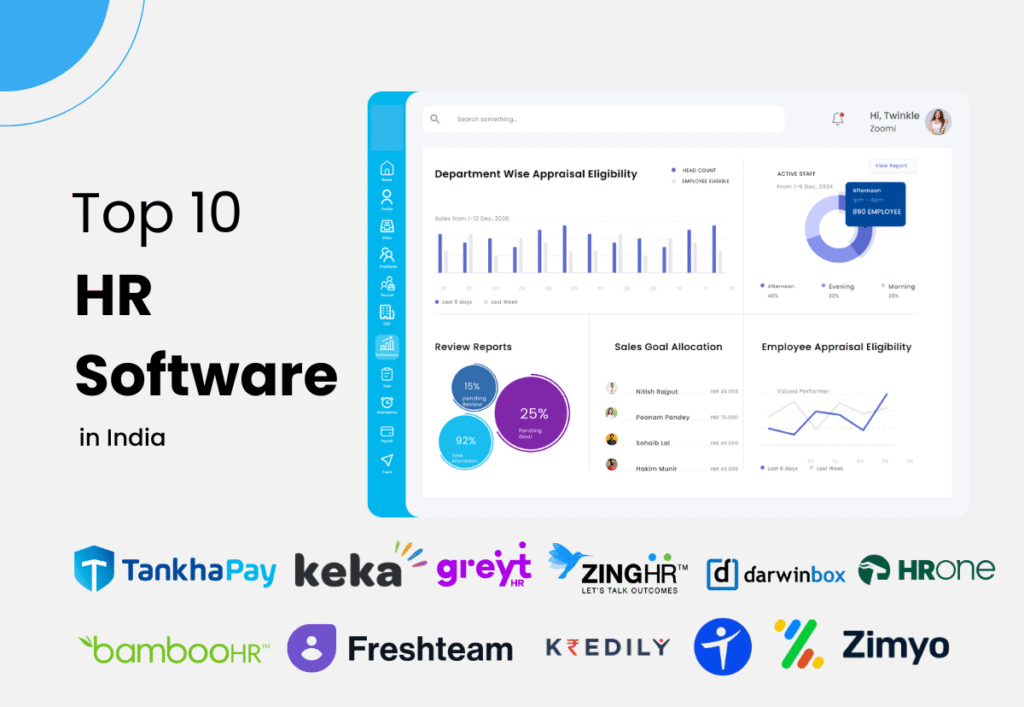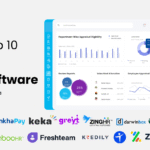India is home to over 63 million MSMEs, 80,000+ startups, and hundreds of global capability centers. Managing people efficiently in this diverse and regulation-heavy market is no longer optional — it’s a business survival factor.
The Indian HR tech market crossed $1.1 billion in 2024 and is projected to touch $2.5 billion by 2030, growing at a CAGR of 14–16%. Rapid digital adoption, four new labour codes, mandatory e-invoicing under GST, and the rise of hybrid work have made modern HR software in India indispensable for every company — whether you have 10 employees or 100,000.
This 2000+ word guide covers everything you need to know about choosing, implementing, and maximizing HR software in India in 2025.
What Exactly is HR Software (HRMS/HRIS)?
HR software — also called HRMS (Human Resource Management System) or HRIS (Human Resource Information System) — is a digital platform that automates and centralizes all people-related processes.
In the Indian context, the best HR software goes beyond global templates. It is built ground-up for:
- Indian payroll statutory rules (PF, ESI, PT, LWF, Bonus, Gratuity)
- Multi-state labour law variations
- TDS computation & Form 16/24Q generation
- Direct integration with Indian banks via APIs
- Support for regional languages and Aadhaar/e-sign
Modern HR software in India comes in three broad formats:
- All-in-one HRMS (payroll + core HR + talent management)
- Best-of-breed tools (specialized in payroll, recruitment, or performance)
- Cloud vs On-premise (99% new buyers now choose cloud)
10 Game-Changing Benefits of Using HR Software in India
- 100% Statutory Compliance Automatic updates for changing PF rates, ESI slabs, minimum wages across states, and new labour codes.
- Massive Time Savings Indian companies report saving 15–30 hours per month on payroll and attendance alone.
- Error-Free Payroll Eliminate Excel mistakes that lead to notices from IT, PF, or labour departments.
- Superior Employee Experience Mobile self-service portals for payslips, tax declarations, leave applications, and investment proofs.
- Reduced HR Operational Cost SMEs save 25–40% on HR administration costs within the first year.
- Data-Driven Decisions Real-time dashboards on attrition, gender ratio, cost-to-company, and productivity.
- Faster & Better Hiring Built-in Applicant Tracking System (ATS) reduces time-to-hire by up to 50%.
- Seamless Remote & Hybrid Work Management Geo-tagging, facial recognition attendance, and virtual onboarding.
- Scalability Without Pain Grow from 20 to 20,000 employees on the same platform without changing software.
- Audit-Ready Records One-click generation of reports required by labour inspectors or investors.
Must-Have Features in Indian HR Software (2025 Edition)
Core Modules Every Business Needs
- Employee lifecycle management (join to exit)
- Centralized employee database with document vault
- Org chart builder
Payroll & India-Specific Compliance
- Full & final settlement automation
- Arrears, reimbursement, and loan management
- Direct bank transfer & digital payslips
- Auto Form 16, 24Q, PF/ECR, ESI, PT, LWF challans
Attendance & Leave
- Biometric/mobile/GPS/web clock-in
- Shift rostering & overtime calculation
- Custom leave policies (earned leave, sick leave, comp-off)
Recruitment & Onboarding
- Career page & job board integration
- Resume parsing & candidate ranking
- Offer letter & background verification workflows
Performance & Learning
- OKR/goal setting & continuous feedback
- 9-box grid & bell curve
- Learning Management System (LMS) integration
Employee Self-Service & Mobile App
- Investment declaration & tax planner
- Expense claims & reimbursement
- Chatbot for instant query resolution
Analytics & Integrations
- 100+ pre-built reports + custom report builder
- Integration with Tally, Zoho Books, QuickBooks, Slack, Google Workspace, Microsoft 365
Security & Compliance
- ISO 27001 & SOC 2 certified
- Data residency in India
- Role-based access & audit logs
Top 12 HR Software in India for 2025 (Ranked by Segment)
Best for Startups (<100 employees)
- Keka – Modern UI, strong payroll, affordable
- Zoho People – Free for up to 5 users, deep Zoho integration
- Qandle – Extremely simple, great mobile app
Best for Growing SMEs (100–1000 employees)
- greytHR – Undisputed leader in payroll & compliance
- Pocket HRMS – AI chatbot + biometric focus
- Spine HR – Feature-rich and cost-effective
- Zimyo – Fast-growing, excellent customer support
Best for Enterprises (1000+ employees)
- Darwinbox – AI-first, used by Paytm, Swiggy, JSW
- PeopleStrong – Strong in manufacturing & retail
- SAP SuccessFactors / Workday – Global giants with India localization
- Oracle HCM Cloud – Preferred by banks & IT services majors
- HONO – Rising AI-driven challenger
How to Choose the Perfect HR Software for Your Indian Company
Follow this 7-step framework:
- Map Your Current Pain Points Is payroll taking 4 days? Is compliance risky? Is hiring slow?
- Define Must-Have vs Nice-to-Have Features Statutory compliance and mobile app are usually non-negotiable.
- Set a Realistic Budget Average pricing in 2025:
- ₹60–120 per employee per month for startups/SMEs
- ₹150–300 for enterprises with advanced analytics
- Check India-Specific Checks
- Is the vendor headquartered or has a strong team in India?
- Do they release compliance updates within 7 days of law change?
- Do they have direct integration with ICICI/HDFC/SBI for salary credit?
- Take Demos of 3–4 Shortlisted Tools Involve your finance head and one frontline employee in the demo.
- Ask for Customer References in Your Industry A manufacturing client reference is more valuable than a generic tech one.
- Start with a Paid Pilot (30–90 days) Most vendors now allow this at nominal cost.
Step-by-Step Implementation Roadmap
Month 0: Project kickoff & team formation Month 1: Data cleanup & master creation Month 2: Parallel run (old system + new HR software) Month 3: Go-live for payroll & attendance Month 4–6: Roll out performance, recruitment, and analytics modules
Pro Tip: Allocate 1–2 dedicated HR champions for the project — implementation success rate jumps from 40% to 90% with internal ownership.
Real Success Stories from Indian Companies
→ A Gurugram-based SaaS startup reduced hiring time from 42 to 19 days using Keka’s ATS. → A Pune manufacturing SME eliminated ₹4.8 lakh in annual labour law penalties after switching to greytHR. → A listed retail chain with 18,000 employees across 9 states saved ₹11 crore in compliance costs in two years using Darwinbox.
The Future of HR Software in India (2026–2030)
- Generative AI for writing JD’s, performance reviews, and policies
- Voice-first interfaces in regional languages
- Blockchain for tamper-proof offer letters and certificates
- Predictive attrition models with 85%+ accuracy
- Integration with UPI for instant salary and gig worker payments
- Mandatory ESG & diversity reporting built into HR dashboards
Final Thoughts
The days of managing HR through Excel sheets, WhatsApp groups, and paper files are officially over. Whether you are a bootstrapped startup in Tier-2 India or a unicorn with global ambitions, the right HR software in India will save you time, money, and sleepless nights over compliance.
Take the first step today — shortlist 3 tools, book demos, and run a pilot before March 2026 (when the next round of labour code changes is expected).
Your people deserve a world-class experience. Give it to them with the power of modern HR software in India.


